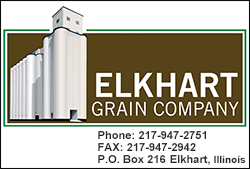|
 Dear Friends, Dear Friends,
Just as the Pilgrims and Native Americans celebrated that first
successful harvest, we have continued the tradition here in the
USA.
No more relevant is this holiday than in the Illinois Farming
Community. IL production agriculture families make up a large
part of the finest and most productive growers in this country.
The rest of us thank each of you for your hard work and ability
in feeding the people here and around the world.
Illinois USDA FSA’s mission is to inform the public about farm
programs; to eliminate barriers for farmers and ranchers; and to
broaden program participation to all communities. Your patronage
is valued and your confidence is appreciated. We are thankful to
count you as friends and customers.
Wishing you a Happy Thanksgiving,
Sincerely,
Scherrie V. Giamanco
State Executive Director

Loans for Targeted Underserved Producers
FSA has a number of loan programs available to assist applicants
to begin or continue in agriculture production. Loans are
available for operating type loans and/or to purchase or improve
farms or ranches.
While all qualified producers are eligible to apply for these
loan programs, FSA has provided priority funding for members of
targeted underserved applicants.
A targeted underserved applicant is one of a group whose members
have been subjected to racial, ethnic or gender prejudice
because of his or her identity as members of the group without
regard to his or her individual qualities.
For purposes of this program, targeted underserved groups are
women, African Americans, American Indians, Alaskan Natives,
Hispanics, Asian Americans and Pacific Islanders.
FSA loans are only available to applicants who meet all the
eligibility requirements and are unable to obtain the needed
credit elsewhere
Guaranteed Loan Program
FSA guaranteed loans allow lenders to provide agricultural
credit to farmers who do not meet the lender's normal
underwriting criteria. Farmers and ranchers apply for a
guaranteed loan through a lender, and the lender arranges for
the guarantee. FSA can guarantee up to 95 percent of the loss of
principal and interest on a loan. Guaranteed loans can be used
for both farm ownership and operating purposes.
Guaranteed farm ownership loans can be used to purchase
farmland, construct or repair buildings, develop farmland to
promote soil and water conservation or to refinance debt.
Guaranteed operating loans can be used to purchase livestock,
farm equipment, feed, seed, fuel, farm chemicals, insurance and
other operating expenses.

FSA can guarantee farm ownership and operating loans up to
$1,399,000. Repayment terms vary depending on the type of loan,
collateral and the producer's ability to repay the loan.
Operating loans are normally repaid within seven years and farm
ownership loans are not to exceed 40 years.
Please contact your lender or local FSA farm loan office for
more information on guaranteed loans.
Beginning Farmer Loans
FSA assists beginning farmers to finance agricultural
enterprises. Under these designated farm loan programs, FSA can
provide financing to eligible applicants through either direct
or guaranteed loans. FSA defines a beginning farmer as a person
who:
Has operated a farm for not more than 10 years
Will materially and substantially participate in the operation
of the farm
Agrees to participate in a loan assessment, borrower training
and financial management program sponsored by FSA
Does not own a farm in excess of 30 percent of the county’s
average size farm
Additional program information, loan applications, and other
materials are available at your local USDA Service Center. You
may also visit
www.fsa.usda.gov.
USDA Issues Safety-Net Payments to Farmers Facing Market
Downturn
USDA’s Farm Service Agency (FSA) has announced that beginning
today, nearly one half of the 1.7 million farms that signed up
for either the Agriculture Risk Coverage (ARC) or Price Loss
Coverage (PLC) programs will receive safety-net payments for the
2014 crop year.
Unlike the old direct payments program, which paid farmers in
good years and bad, the 2014 Farm Bill authorized a new
safety-net that protects producers only when market forces or
adverse weather cause unexpected drops in crop prices or
revenues.

Example: The corn price for 2014 is 30 percent below the
historical benchmark price used by the ARC-County program, and
revenues of the farms participating in the ARC-County program
are down by about $20 billion from the benchmark during the same
period. The nearly $4 billion provided today by the ARC and PLC
safety-net programs will give assistance to producers where
revenues dropped below normal.
The ARC/PLC programs primarily allow producers to continue to
produce for the market by making payments on a percentage of
historical base production, limiting the impact on production
decisions.
Nationwide, 96 percent of soybean farms, 91 percent of corn
farms, and 66 percent of wheat farms elected the ARC-County
coverage option. Ninety-nine percent of long grain rice and
peanut farms, and 94 percent of medium grain rice farms elected
the PLC option. Overall, 76 percent of participating farm acres
are protected by ARC-County, 23 percent by PLC, and 1 percent by
ARC-Individual. For data about other crops, as well as
state-by-state program election results, final PLC price and
payment data, and other program information including frequently
asked questions, visit www.fsa.usda.gov/arc-plc.
Crops receiving assistance include barley, corn, grain sorghum,
lentils, oats, peanuts, dry peas, soybeans, and wheat. In the
upcoming months, disbursements will be made for other crops
after marketing year average prices are published by USDA’s
National Agricultural Statistics Service. Any disbursements to
participants in ARC-County or PLC for long and medium grain rice
(except for temperate Japonica rice) will occur in November, for
remaining oilseeds and also chickpeas in December, and temperate
Japonica rice in early February 2016. ARC-individual payments
will begin in November. Upland cotton is no longer a covered
commodity.
The Budget Control Act of 2011, passed by Congress, requires
USDA to reduce payments by 6.8 percent. For more information,
producers are encouraged to visit their local Farm Service
Agency office. To find a local Farm Service Agency office, visit
http://offices.usda.gov.

Producers are Reminded to Complete NASS Crop Surveys
The National Agricultural Statistics Service (NASS) Field
Offices are currently completing 2015 small grain yield surveys
and will contact growers in December to complete row crop yield
surveys. If you are one of the producers contacted to complete a
2015 yield survey, we encourage your participation and
cooperation as many USDA agencies including the Farm Service
Agency (FSA) and Risk Management Agency (RMA) use the NASS yield
data for their programs.
FSA uses NASS county yield data for farm credit, conservation,
disaster programs, loan, and commodity programs. Under the 2014
Farm Bill, FSA uses the NASS county yield data to calculate
Agriculture Risk Coverage – County (ARC-CO) benchmark revenues
and current year county revenues. For example, the 2014 NASS
county yield, along with the crop’s marketing year average price
(MYA), are used to determine the county’s current year revenue
to determine if the county will trigger an ARC-CO payment. An
ARC-CO payment is triggered for a county when the current year
revenue falls below the guarantee revenue for the crop and the
crop year. In cases where NASS county yield data is not
available, the FSA State Committee must determine a county yield
using RMA yield data or the best available yield data, including
assigning a county yield using neighboring county yields from
NASS or RMA.
[to top of second column] |

Any information that producers provide to NASS is kept
confidential and protected by federal law. NASS publishes only
aggregate-level data, ensuring that no individual operation or
producer can be identified. All reports will be available at
www.nass.usda.gov.
USDA Announces Changes to Fruit, Vegetable and Wild Rice
Planting Rules
Farm Service Agency (FSA) has announced fruit, vegetable and
wild rice provisions that affect producers who intend to
participate in certain programs authorized by the Agricultural
Act of 2014.
Producers who intend to participate in the Agriculture Risk
Coverage (ARC) or Price Loss Coverage (PLC) programs are subject
to an acre-for-acre payment reduction when fruits and nuts,
vegetables or wild rice are planted on the payment acres of a
farm. Payment reductions do not apply to mung beans, dry peas,
lentils or chickpeas.
Planting fruits, vegetables or wild rice on acres that are not
considered payment acres will not result in a payment reduction.
Farms that are eligible to participate in ARC/PLC but are not
enrolled for a particular year may plant unlimited fruits,
vegetables and wild rice for that year but will not receive
ARC/PLC payments for that year. Eligibility for succeeding years
is not affected.
Planting and harvesting fruits, vegetables and wild rice on
ARC/PLC acreage is subject to the acre-for-acre payment
reduction when those crops are planted on either more than 15
percent of the base acres of a farm enrolled in ARC using the
county coverage or PLC, or more than 35 percent of the base
acres of a farm enrolled in ARC using the individual coverage.

Fruits, vegetables and wild rice that are planted in a
double-cropping practice will not cause a payment reduction if
the farm is in a double-cropping region as designated by the
USDA’s Commodity Credit Corporation.
2011, 2012, 2013 and 2014 Average Adjusted Gross Income
Compliance Reviews
The AGI verification and compliance reviews for 2011, 2012, 2013
and 2014 are conducted on producers who the IRS indicated may
have exceeded the adjusted gross income limitations described in
[7 CFR 1400.500]. Based on this review, producers will receive
determinations of eligibility or ineligibility.
If the producer is determined to have exceeded the average AGI
limitation of $900,000, receivables will be established for
payments earned directly or indirectly by the producer subject
to the $900,000 limitation. The Illinois FSA State Office has
begun notifying producers selected for review. If you have any
questions about the review process or determinations, please
contact the Illinois FSA State Office at 217-241-6600. Producers
who receive initial debt notification letters may only appeal
the amount of the debt to their local FSA office. Payment
eligibility adverse determinations become administratively final
30 days from the date of the payment eligibility adverse
determination letter and can only be reopened if exceptional
circumstances exist that prevented the producer from timely
filing the appeal.
FSA County Committee Election
DON'T MISS OUT ON VOTING
Ballots will be mailed to voters by Nov. 9, 2015, and must be
returned to the FSA county office or postmarked by Dec. 7, 2015.
Eligible voters must contact their local FSA county office
before the final date if they did not receive a ballot.

WHO CAN VOTE
Agricultural producers of legal voting age may be eligible to
vote if they participate or cooperate in any FSA program. A
person who is not of legal voting age but supervises and
conducts the farming operations of an entire farm also may be
eligible to vote. Members of American Indian tribes holding
agricultural land are eligible to vote if voting requirements
are met. More information about voting eligibility requirements
can be found in the FSA fact sheet titled “FSA County Committee
Election - Eligibility to Vote and Hold Office as a County
Committee Member” http://www.fsa.usda.gov/
news-room/county-committee-elections/index.
Producers may contact their local FSA county office for more
information. To find your local FSA county office, visit
http://offices.usda.gov.
November Interest Rates
90 Day Treasury Bill .125%
Direct Farm Operating Loans 2.50%
Direct Farm Ownership Loans 3.875%
Farm Ownership Loans -
Direct Down Payment,
Beginning Farmer or Rancher 1.50%
Emergency Loans 3.50%
Farm Storage Facility Loans
(7 years) 1.750%
Farm Storage Facility Loans
(10 years) 2.125%
Farm Storage Facility Loans
(12 years) 2.250%
Commodity Loans 1996-
Present 1.250%

Dates to Remember
USDA is an equal opportunity provider and employer. To file a
complaint of discrimination, write: USDA, Office of the
Assistant Secretary for Civil Rights, Office of Adjudication,
1400 Independence Ave., SW, Washington, DC 20250-9410 or call
(866) 632-9992 (Toll-free Customer Service), (800) 877-8339
(Local or Federal relay), (866) 377-8642 (Relay voice users).
November 20 NAP application closing date for bi-annual
and perennial crops, such as
apples, asparagus, blueberries, caneberries, cherries, grapes,
hops, nectarines, peaches, pears, plums, rhubarb, and
strawberries
November 20 Deadline to enroll in 2016 MPP-Dairy coverage
November 26 Thanksgiving Day Holiday - FSA Offices Closed
December 1 Conservation Reserve Program (CRP) General
Signup begins and continues
through Feb. 26, 2016
December 7 Last day to return County Committee Election
ballots to County FSA Offices
Illinois Farm Service Agency
3500 Wabash Ave
Springfield, IL 62711
www.fsa.usda.gov/il
State Committee:
Jill Appell - Chair
Brenda Hill - Member
Jerry Jiminez - Member
Joyce Matthews - Member
Gordon Stine - Member
State Executive Director:
Scherrie V. Giamanco
State Executive Officer:
Rick Graden
Administrative Officer:
Dan Puccetti
Division Chiefs:
Doug Bailey
Jeff Koch
Stan Wilson
Please contact your local FSA Office for questions specific to
your operation or county.
 |